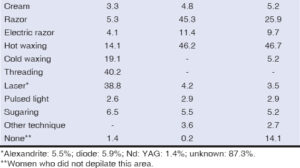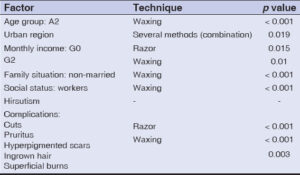Body hair removal: A cross-sectional survey among women in the north of Morocco
Ibtissam Al faker 1, Farah Marraha1, Adil Gourinda2, Fadila Bousgheiri2, Hanane Chahoub1, Najlae Rahmani1, Adil Najdi2, Salim Gallouj1
1, Farah Marraha1, Adil Gourinda2, Fadila Bousgheiri2, Hanane Chahoub1, Najlae Rahmani1, Adil Najdi2, Salim Gallouj1
1Department of Dermatology, University Hospital Center of Tangier, Morocco, 2Department of Epidemiology, University Hospital Center of Tangier, Morocco
Citation tools:
Copyright information
© Our Dermatology Online 2024. No commercial re-use. See rights and permissions. Published by Our Dermatology Online.
ABSTRACT
Objectives: Our study aimed to determine the prevalence and techniques of body hair removal. In addition, we also looked at the various complications that had arisen in our patient group.
Materials and Methods: An online, anonymous, cross-sectional survey was conducted in the north region of Morocco to collect data that was sent to participants who live in one of the cities of northern Morocco. IBM SPSS, version 25, was employed to analyze the data with descriptive and inferential statistics.
Results: A total of 660 randomly selected women responded to the questionnaire. The mean age was 31.02 ± 8.89 (SD). Pubic and axillary hair were the most often depilated areas (90–94%). The main reason was hygiene (46.9%). Age, income, family situation, and social status were significantly associated with body hair removal areas and methods. The complications that occurred in different parts of the body were minimal and similar to those already reported in the literature for pubic grooming. They were mainly associated with the technique of removal.
Conclusion: Younger women were more likely to remove hair from the face, forearms, and legs when compared to the older. Traditional techniques such as waxing and shaving were still the most often employed.
Key words: Body areas, Complications, Hair removal, Regional survey, Techniques
What is known about this subject in regard to women and their families?
- Hair removal is above all a women’s issue.
- Although the practice is highly popular, there are still complications related to various hair removal methods.
What is new from this article as messages for women and their families?
- There is no previously published data on the prevalence, techniques, and complications of body hair removal among women in our region.
- More effort is needed to educate women to choose the most appropriate technique with fewer complications.
INTRODUCTION
Pubic hair removal is a common practice that several university centers have studied, especially, in the U.S., Germany, Brazil, the U.K., New Zealand, Saudi Arabia, and Lebanon [1–10]. Its prevalence and characteristics in women are more reviewed; in fact, grooming is associated with younger age, light phototype, higher educational level, being under or normal weight, and high-income employment [2,11–13]. In an American study, being a current and complete groomer was more associated with sexual activity and having multiple partners, which involves better sex life satisfaction [2]. Shaving remains the most widely used method [6], and the most often reported injuries are related to this technique [11,14]. Recently, there has been an increase in the occurrence of sexually transmitted infections from contaminated tools in beauty salons and of pubic grooming injuries, among which the most common type was laceration [14,15].
Over the past several years, total body hair removal has become a trend, so much that popular nomenclature has changed from “normal body hair” to “unwanted hair”; it is an increasingly common practice, especially among young women, to conform to modern norms. The role of social media, models, and advertisements is non-negligible in the establishment of standard concepts of beauty and attractiveness, to which hairless skin is an important criterion. Although widespread, there is no data concerning socio-demographic correlates, reasons, methods, and of course, complications of body hair removal among women living in northern Morocco. Our study aimed to determine the prevalence, techniques, and complications of personal hair removal practices and search for the sociodemographic characteristics of this region.
MATERIALS AND METHODS
Survey
An anonymous online survey was established in Google Forms. Before beginning the questions, a short paragraph informed the participants about the objectives of the study, confirming anonymity and obtaining their consent to use the data for scientific purposes. Fifteen minutes was sufficient to complete the entire questionnaire. Multiple or short choice responses were proposed with some photos to make answers easier. The first section of the questionnaire contained demographic data such as age, social status, income, region and city of residence, family situation, and medical history, for instance, hirsutism and age at menarche, and also contained a question about advice received on hair removal. The second section consisted of specific information such as age of initiation, reasons, use of an anesthetic cream before and soothing cream after the procedure, and self-hair removal or recourse to professionals. Then, each part of the body was dealt separately—which part to depilate (face: eyebrow, upper lip, and chin; armpit and pubic area, forearms and legs, other parts), which technique (threading, laser, razor, wax, cream, sugaring, pulsed light, other methods), what frequency of hair removal (once a week, once per month, or more rarely), and what complications (contact dermatitis, herpes, pruritus, folliculitis, hyperpigmentation, ingrown hair, ecchymosis, cuts, and superficial burn)—before ending with a question about consulting a doctor (dermatologist or generalist) in the case of complications.
Statistical Analysis
Statistical analysis was conducted by the team at the epidemiology and public health department of Tangier University Hospital Center. The collected data was analyzed by SPSS, version 25. Chi-squared and Fisher’s exact tests were employed to compare categorical variables. The p value was considered significant if it was below 0.05.
RESULTS
General Characteristics
The target population of the study was women living in northern Morocco. A total of 660 women responded to the questionnaire, aged between 15 and 72 years. The mean age was 31.02 ± 8.89 (SD). The age at menarche was 13.06 ± 1.57 (median ± SD). Age at beginning hair removal was 16.16 ± 3.63 (mean ± SD) (Table 1).
Nineteen percent of the women suffered from hirsutism. 63.9% removed their hair themselves, while 36.1% appealed to a professional staff: 4.8% in medical practices or clinics and 31.2% in beauty salons. Before hair removal, only 2.1% of the participants used an anesthetic cream, yet after, 46.6% of them used a soothing cream. Reasons for depilation were as follows: hygiene (46.9%), aesthetic and appearance (9.3%), medical (2.9%), and a combination of reasons (40.9%) (religion and hygiene in the armpits and pubic area, aesthetic in other parts of the body). The frequency of hair removal was once per week in 28.9%, once a month in 62.1%, and less frequently in 8.9%.
Body Areas
94.2% of all women participants removed axillary hair, 90% pubic hair, 82.7% from the legs, 65.3% from the upper lip, 42.3% from the forearms, 39.5% from the eyebrows, 19.2% from the chin, and 13% from other regions of the body.
The age effect was significantly associated with the depilated body parts. Younger women aged between 21 and 40 years (age group A2 in Table 1) were more likely to remove hair from the upper lip (n = 374, p < 0.001), from the forearms (n = 254, p < 0.001), and from the legs (n = 456, p = 0.002), while women over the age of 40 (age group A3) were the least likely to remove hair from the forearms (n = 11, p < 0.001).
Techniques
Several techniques were used for each part with different frequencies, yet a combination of various methods was also reported (Table 2). In fact, for the face, threading was the most frequently employed technique (n = 265, 40.2%), followed by laser (n = 256, 38.8%). For the axillary and pubic hair, it was rather hot waxing (n = 305, 46.2%), followed by the razor (n = 299, 45.3%). Hot waxing (n = 308, 46.7%) and the razor (n = 171, 25.9%) were used also for the legs and forearms yet with a different prevalence.
For axillary and pubic hair removal, participants of age group A2 did not use the razor (p < 0.001) but rather waxing (p < 0.001), same for the legs and forearms (p < 0.001). Other techniques were most frequently used by younger women (A2) living in urban regions to depilate their axillary and pubic hair (p = 0.019).
Regarding medical history, women with hirsutism chose to remove excess hair by laser (p = 0.033). According to them, the latter ensured better results and a long-lasting effect.
Monthly income was strongly associated with the technique used in different body areas. Group I.0 was significantly associated with the use of the razor (p = 0.015), group I.2 with hot waxing (p = 0.013), and group I.3 with laser (p = 0.01) (Tables 3, 4, and 5). In the same way, non-married women were more likely to remove their hair from the axillary and pubic areas and the forearms and legs with hot waxing (p < 0.001 and p = 0.01, respectively) and from the face with threading (p = 0.011). Employment was statistically related to the choice of technique: workers tended to remove their axillary and pubic hair with the razor (p < 0.001) while using waxing for the face, forearms, and legs (p < 0.001).
Complications
The participants reported several complications, sometimes combined: ingrown hair (n = 269, 40.8%), hyperpigmented scars (n = 137, 20.8%), cuts (n = 111, 16.8%), itching (n = 102, 15.5%), and folliculitis (14.4%), while 198 of the participants reported no complications (30%) (Table 1). 6.2% of these complications occurred on the face, 32.3% in the axilla and pubic area, and 23% on the legs and forearms (Tables 3, 4, and 5). Only 24.8% of the women had resorted to consulting the physician (142 the dermatologist vs. 22 the general practitioner in the case of complications).
DISCUSSION
Hair removal is one of the most requested services in aesthetics. It is a question of trend with the desire to remain beautiful and soft. Women remove body hair for numerous reasons. Hygiene was the most often reported reason in our study population, with a frequency of once a month in 62.2% (n = 499) in the axillary and pubic regions. In an American survey, Gaither et al. found that women also remove their pubic hair for social events as well as when they consult a health professional [5]. The present study sought to examine personal hair removal behaviors, determine the prevalence of complications, and specify the sociodemographic characteristics in a representative sample of women living in northern Morocco. Although this practice is common and popular, no data is found in our country, with most studies focusing on women (some on both women and men) in the U.S. and Europe.
Labre reported in his manuscript in 2002 that, after the end of the Second World War, pubic hair removal became standardized, and this is for some reasons, such as womanliness, good hygiene, and sexuality [16]. However, we believe that that study was intended for the American population (even Europeans), since it is known that Islamic legislation specifies that pubic and axillary hair removal must be initiated at the age of menarche and performed at least once every forty days [17,18]. In our study, we found that not all participants removed their axillary and pubic hair, and this was probably because the earliest age of hair removal was higher than that of menarche or the fact that terminal hair at puberty does not become denser until stage 4 of the Tanner classification [19]. In a Saudi survey of pubic hair removal among women, all removed pubic hair, and this practice began at the age of menarche [1]. However, another study found a higher age of initiation for pubic hair removal, which varied from 16.40 ± 3.87 to 18.35 ± 4.34 years depending on ethnic origin [2].
Almost half (51.4%) of the participants in our questionnaire had never received advice on body hair removal, while for 39.8% of the women, the main source of information was their mothers, sisters, and friends; which demonstrated that, despite the current trend and the availability of several sources of information, the role of the family remains irreplaceable regarding education and outreach. In line with this founding, two studies confirmed that the participant’s mothers remained the preferred source of knowledge and advice [1,20].
Being hairy has become a real scourge and a symbol of self-neglect, which is why young women are more likely to shave their forearms, legs, and facial hair. Borkenhagen et al. [3] conducted a survey among men and women in Germany and concluded that the female sex and young age were significant determinants for pubic hair removal. The same results have been reported in other research [4,5]. According to Borkenhagen et al. [3], there was a significant association between hair removal customs and body experience measured by FBeK. Incredibly, insecurity and discomfort are more expressed by removers of pubic and axillary hair, and they showed a lower level of attractiveness and self-confidence when compared to non-removers. This may be the result of a stronger focus on body standards.
This survey showed that younger women, workers, non-married, and women who earn between 5000 and 10000 DH/month were the most likely to wax other parts of their body, especially the forearms and legs. Consequently, the complications that have occurred were related to this method. For axillary and pubic hair, the two most often depilated parts of body hair, women still preferred traditional techniques, such as shaving and waxing, and these selected methods were significantly associated with monthly income (group I.0 with shaving p = 0.015 and group I.2 with waxing p = 0.01). Muallaaziz et al., in a Turkish survey [20], reported the same results.
Our results corroborated previous studies in terms of complications [6,7]. These were minor, such as ingrown hair, hyperpigmentation, itching, and minor cuts. Nevertheless, certain cases (24.8%) did require treatment. Interestingly, a significant association was found between laser and the absence of herpes (p = 0.022), and this may be explained by the systematic prevention of herpes after each laser session. However, serious complications have been reported in the literature, such as cuts, lacerations, molluscum contagiosum, staphylococcal infections, and abscesses, which were caused mostly by razor and waxing [8]. The risk of contracting sexually transmitted diseases from contaminated tools in beauty salons has also been reported, which are uncommon cases of primary genital herpes [21]. Nevertheless, all these reported complications were related to pubic hair removal since this area of the body remains the most studied. Although similar, to our knowledge, this was the first study to report body hair removal complications. Borkenhagen et al. were more interested in body image and experience [3].
As in all surveys, ours had its limits and strengths. The majority of the participants were young workers. However, the sample was random. To our knowledge, this was the only study to examine total body hair removal practices and complications in our country. Thus, to achieve definitive conclusions, it would be helpful to perform a similar study in other regions of Morocco and compare results.
Studies on women’s body hair removal enrich our knowledge about the motivation, methods, and problems of depilation. Nevertheless, we should not overlook that such issues are subject to numerous factors and considerations that influence women’s choices. Chief among them are religious and cultural beliefs. Thus, we cannot compare two different cultures or generalize findings from studies conducted in American or European populations to Muslim women.
Statement of Human and Animal Rights
All the procedures followed were in accordance with the ethical standards of the responsible committee on human experimentation (institutional and national) and with the 2008 revision of the Declaration of Helsinki of 1975.
Statement of Informed Consent
Informed consent for participation in this study was obtained from all patients.
REFERENCES
1. Rouzi AA, Berg RC, Turkistani J, Alamoudi R, Alsinani N, Alkafy S, et al. Practices and complications of pubic hair removal among Saudi women. BMC Women’s Health. 2018;18:1-6.
2. DeMaria AL, Berenson AB. Prevalence and correlates of pubic hair grooming among low-income Hispanic, Black, and White women. Body Image. 2013;10:226-31.
3. Borkenhagen A, Mirastschijski U, Strauss B, Gieler U, Braehler E. Body hair removal:Prevalence, demographics, and body experience among men and women in Germany. J Cosmet Dermatol. 2020;19:2886-92.
4. Rowen TS, Gaither TW, Awad MA, Osterberg EC, Shindel AW, Breyer BN. Pubic hair grooming prevalence and motivation among women in the United States. JAMA Dermatol. 2016;152:1106-13.
5. Gaither TW, Awad MA, Osterberg EC, Rowen TS, Shindel AW, Breyer BN. Prevalence and motivation:Pubic hair grooming among men in the United States. Am J Mens Health. 2017;11:620-60.
6. Butler SM, Smith NK, Collazo E, Caltabiano L, Herbenick D. Pubic hair preferences, reasons for removal, and associated genital symptoms:Comparisons between men and women. J Sex Med. 2015;12:48-58.
7. Attieh E, Maalouf S, Roumieh D, Abdayem P, AbiTayeh G, Kesrouani A. Feminine hygiene practices among female patients and nurses in Lebanon. Reprod Health. 2016;13:59.
8. Baxi LV, Dziadosz M. Complications following “Brazilian”waxing for pubic hair removal. Am J Obstet Gynecol. 2014;211:713-4.
9. Toerien M, Wilkinson S. Gender and body hair:Constructing the feminine woman. Womens Stud Int Forum. 2003;26:333-44.
10. Terry G, Braun V. To let hair be, or to not let hair be?Gender and body hair removal practices in Aotearoa/New Zealand. Body Image. 2013;10:599-606.
11. DeMaria AL, Flores M, Hirth JM, Berenson AB. Complications related to pubic hair removal. Am J Obstet Gynecol. 2014;210:528.e1-528.e5285.
12. Herbenick D, Schick V, Reece M, Sanders S, Fortenberry JD. Pubic hair removal among women in the United States:Prevalence, methods, and characteristics. J Sex Med. 2010;7:3322-30.
13. Herbenick D, Hensel D, Smith NK, Schick V, Reece M, Sanders SA, et al. Pubic hair removal and sexual behavior:Findings from a prospective daily diary study of sexually active women in the United States. J Sex Med. 2013;10:678-85.
14. Glass AS, Bagga HS, Tasian GE, Fisher PB, McCulloch CE, Blaschko SD, et al. Pubic hair grooming injuries presenting to US emergency departments. Urology. 2012;80:1187-91.
15. Gaither TW, Truesdale M, Harris CR, Alwaal A, Shindel AW, Allen IE, et al. The Influence of sexual orientation and sexual role on male grooming?related injuries and infections. J Sex Med. 2015;12:631-40.
16. Labre MP. The Brazilian wax:New hairlessness norm for women?J Commun Inq. 2002;26:113–32.
17. AlGhamdi KM, AlHomoudi FA, Khurram H. Skin care:Historical and contemporary views. Saudi Pharm J. 2014;22:171-8.
18. Al-Sabbagh ML. The right path to health. Health education through religion. Islamic ruling on male and female circumcision. World Health Organization. 1996.
19. Emmanuel M, Bokor BR. Tanner Stages. 2022.
20. Muallaaziz D, Yayci E, AtaçağT, Kaptanoğlu AS. Pubic hair removal practices in Muslim women. Basic Clin Sci. 2014;3:39-44.
21. Schmidtberger L, Ladizinski B, Ramirez-Fort MK. Wax on, wax off:Pubic hair grooming and potential complications. JAMA Dermatol. 2014;150:122.
Notes
Request permissions
If you wish to reuse any or all of this article please use the e-mail (brzezoo77@yahoo.com) to contact with publisher.
| Related Articles | Search Authors in |
|
 http://orcid.org/0000-0001-8134-2579 http://orcid.org/0000-0001-8134-2579 http://orcid.org/0000-0002-4465-954X http://orcid.org/0000-0002-4465-954X |









Comments are closed.